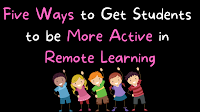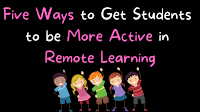
01 Apr Five Ways to Get Students to be More Active in Remote Learning
This is a guest post from Hali Larkins (@HaliLarkins), communications intern at The Learning Accelerator and Master’s student at Columbia Teachers’ College.
In remote environments, sustaining engagement is a challenging task even for adults, but with school continuing to take place virtually, the question of “How to motivate and keep students engaged in remote learning?” continues to be top of mind for many teachers. In exploring this question, The Learning Accelerator has outlined five key steps to getting and keeping students engaged:
1. Be Clear and Consistent:
Classroom agendas can be recreated virtually to offer students a central place to track objectives and activities for the lessons. Tools such as virtual notebooks, online agendas, and visual virtual classrooms can establish consistency for students.
2. Provide Opportunities for Ownership and Choice:
Systems such as classroom jobs, choice boards, and award systems can be designed for virtual contexts to both give students something to look forward to and establish a sense of agency in their learning.
3. Offer Opportunities Non Verbal Engagement:
Normalizing non-verbal communication through strategies such as wait questions, muted share alouds, and communicating with hand signals allows for variety in classroom participation.
4. Establish Effective Small-Group Collaboration:
Establishing clear expectations, assigning group roles, and providing space for wellbeing check-ins can help students build community and connection with their peers in across both remote and in-person environments.
5. Build Movement in Lessons:
In remote learning, students are generally less active than usual. Teachers can motivate students to get active by offering brain breaks, creating active activities, and providing virtual scavenger hunts.
The key to designing engaging remote learning experiences is for them to be fun, interesting, and account for the full needs of students during these times. We want to create learning environments where students feel challenged, emotionally safe, and connected to their learning community — whether remote or in-person.
This is a guest post from Hali Larkins (@HaliLarkins), communications intern at The Learning Accelerator and Master’s student at Columbia Teachers’ College.In remote environments, sustaining engagement is a challenging task even for adults, but with school continuing to take place virtually, the question of “How to motivate and keep students engaged in remote learning?” continues to be top of mind for many teachers. In exploring this question, The Learning Accelerator has outlined five key steps to getting and keeping students engaged: 1. Be Clear and Consistent: Classroom agendas can be recreated virtually to offer students a central place to track objectives and activities for the lessons. Tools such as virtual notebooks, online agendas, and visual virtual classrooms can establish consistency for students. 2. Provide Opportunities for Ownership and Choice: Systems such as classroom jobs, choice boards, and award systems can be designed for virtual contexts to both give students something to look forward to and establish a sense of agency in their learning. 3. Offer Opportunities Non Verbal Engagement: Normalizing non-verbal communication through strategies such as wait questions, muted share alouds, and communicating with hand signals allows for variety in classroom participation. 4. Establish Effective Small-Group Collaboration:Establishing clear expectations, assigning group roles, and providing space for wellbeing check-ins can help students build community and connection with their peers in across both remote and in-person environments.5. Build Movement in Lessons:In remote learning, students are generally less active than usual. Teachers can motivate students to get active by offering brain breaks, creating active activities, and providing virtual scavenger hunts. The key to designing engaging remote learning experiences is for them to be fun, interesting, and account for the full needs of students during these times. We want to create learning environments where students feel challenged, emotionally safe, and connected to their learning community — whether remote or in-person. This post originally appeared on FreeTech4Teachers.com. If you see it elsewhere, it has been used without permission. Sites that steal my work include CloudComputin and 711Web. Free Technology For Teachers, how to, online instruction, Online Learning, remote instruction, remote learning, The Learning AcceleratorRead More
Free Technology For Teachers, how to, online instruction, Online Learning, remote instruction, remote learning, The Learning AcceleratorRead More

Sorry, the comment form is closed at this time.